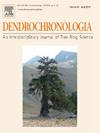消除后期木材蓝强度的过渡木材携带效应以改善美国东部加拿大Tsuga的气候信号
IF 2.7
3区 农林科学
Q1 FORESTRY
引用次数: 0
摘要
长期以来,树木年轮为过去的温度变化和极端情况提供了重要的见解,有助于了解最近的变暖趋势。近几十年来,蓝色强度(BI),一种基于光的反射率方法,已经成为一种广泛使用且具有成本效益的估计密度环生长的工具,通常比径向宽度测量产生更强的温度信号。然而,BI的某些方面仍未得到充分探索,特别是过渡木蓝强度(TBI)对后期木蓝强度(LWBI)的潜在延续效应。在这项研究中,我们分析了加拿大铁杉(Tsuga canadensis)(东部铁杉),以确定去除TBI的结转效应是否会改善LWBI中嵌入的气候信号。在14个站点中,TBI与LWBI显著相关(平均r = 0.42,p <; 0.01),表明存在结转效应。通过去除TBI的影响,调整后的LWBI (LWBIa)降低了春季相关性(3 - 4月;meanΔ =−0.05),与8月气温(meanΔ = +0.04)和生长期平均Tmax(5 - 9月;MeanΔ = +0.04)。LWBIa优于DeltaBI,与DeltaBI的57 %相比,有93 %的网站显示与8月Tmax的相关性有所改善。然而,LWBIa降低了9月份的相关性,限制了夏末平均值(8月至9月)的改善。这些结果表明,通过考虑TBI的结转效应来调整LWBI可以提高8月和生长季节的温度敏感性,从而提高基于bi的重建模型的准确性。需要进一步的研究来评估其他物种和地区的这种调整,以充分评估其更广泛的适用性。本文章由计算机程序翻译,如有差异,请以英文原文为准。
Removing the transition wood carryover effect from latewood blue intensity to improve climate signals from Tsuga canadensis in the eastern United States
Tree rings have long provided critical insights into past temperature variability and extremes, helping to contextualize recent warming trends. In recent decades, blue intensity (BI), a light-based reflectivity method, has become a widely used and cost-effective tool for estimating densiometric ring growth, often yielding stronger temperature signals than radial width measurements. However, certain aspects of BI remain underexplored, particularly the potential of a carryover effect from transition wood blue intensity (TBI) on latewood blue intensity (LWBI). In this study, we analyzed Tsuga canadensis (eastern hemlock) to determine whether removing the carryover effect of TBI improves the climate signal embedded within LWBI. Across 14 sites, TBI was significantly correlated with LWBI (mean r = 0.42, p < 0.01), suggesting a carryover effect. By removing the influence of TBI, the adjusted LWBI (LWBIa) reduced spring correlations (March-April; meanΔ = −0.05) while increasing correlations with August temperatures (meanΔ = +0.04) and growing season average Tmax (May-September; meanΔ = +0.04). LWBIa outperformed DeltaBI, with 93 % of sites showing improved correlations with August Tmax compared to 57 % for DeltaBI. However, LWBIa reduced correlations for September, limiting improvements in late summer averages (August-September). These findings demonstrate that adjusting LWBI by accounting for the carryover effect of TBI can improve temperature sensitivity for August and the growing season, potentially enhancing the accuracy of BI-based reconstruction models. Further studies are needed to evaluate this adjustment across other species and regions to fully assess its broader applicability.
求助全文
通过发布文献求助,成功后即可免费获取论文全文。
去求助
来源期刊

Dendrochronologia
FORESTRY-GEOGRAPHY, PHYSICAL
CiteScore
5.50
自引率
13.30%
发文量
82
审稿时长
22.8 weeks
期刊介绍:
Dendrochronologia is a peer-reviewed international scholarly journal that presents high-quality research related to growth rings of woody plants, i.e., trees and shrubs, and the application of tree-ring studies.
The areas covered by the journal include, but are not limited to:
Archaeology
Botany
Climatology
Ecology
Forestry
Geology
Hydrology
Original research articles, reviews, communications, technical notes and personal notes are considered for publication.
 求助内容:
求助内容: 应助结果提醒方式:
应助结果提醒方式:


